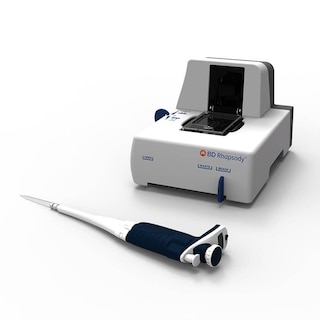-
Your selected country is
Middle East / Africa
- Change country/language
Old Browser
This page has been recently translated and is available in French now.
Looks like you're visiting us from {countryName}.
Would you like to stay on the current country site or be switched to your country?


Oligo Mouse Anti-Human CD371 (Clec12A)
Regulatory Status Legend
Any use of products other than the permitted use without the express written authorization of Becton, Dickinson and Company is strictly prohibited.
Preparation And Storage
Recommended Assay Procedures
Put all BD® AbSeq Reagents to be pooled into a Latch Rack for 500 µL Tubes (Thermo Fisher Scientific Cat. No. 4900). Arrange the tubes so that they can be easily uncapped and re-capped with an 8-Channel Screw Cap Tube Capper (Thermo Fisher Scientific Cat. No. 4105MAT) and the reagents aliquoted with a multi-channel pipette.
BD® AbSeq tubes should be centrifuged for ≥ 30 seconds at 400 × g to ensure removal of any content in the cap/tube threads prior to the first opening.
Product Notices
- This reagent has been pre-diluted for use at the recommended volume per test. Typical use is 2 µl for 1 × 10^6 cells in a 200-µl staining reaction.
- Source of all serum proteins is from USDA inspected abattoirs located in the United States.
- Caution: Sodium azide yields highly toxic hydrazoic acid under acidic conditions. Dilute azide compounds in running water before discarding to avoid accumulation of potentially explosive deposits in plumbing.
- The production process underwent stringent testing and validation to assure that it generates a high-quality conjugate with consistent performance and specific binding activity. However, verification testing has not been performed on all conjugate lots.
- Illumina is a trademark of Illumina, Inc.
- Please refer to http://regdocs.bd.com to access safety data sheets (SDS).
- Please refer to bd.com/genomics-resources for technical protocols.
- For U.S. patents that may apply, see bd.com/patents.
Companion Products






The 50C1 monoclonal antibody specifically binds to human CD371 which is also known as Clec12A (C-type lectin domain family 12 member A), C-type lectin-like molecule 1 (CLL-1), myeloid inhibitory C-type lectin-like receptor (MICL), or dendritic cell-associated lectin 2 (DCAL-2). It is expressed on a variety of cells including monocytes, macrophages, dendritic cells, and granulocytes and perhaps some NK cells. Clec12A is a member of the C-type lectin/C-type lectin-like domain (CTL/CTLD) superfamily. It is a 30 kDa type II transmembrane glycoprotein that has one single C-type lectin-like domain and one cytoplasmic immunoreceptor tyrosine-based inhibitory motif (ITIM). Clec12A has similarity with the β-glucan receptor (Dectin-1) and LOX-1 with high N-glycosylation. There are at least five isoforms due to alternative transcript splicing. Signaling through Clec12A can induce internalization of Clec12A, dendritic cell maturation and the production of cytokines including IL-12. Clec12A may also serve as a negative regulator of activated leukocytes recruited to sites of inflammation.
Development References (5)
-
Chen CH, Floyd H, Olson NE, et al. Dendritic-cell-associated C-type lectin 2 (DCAL-2) alters dendritic-cell maturation and cytokine production. Blood. 2006; 107(4):1459-1467. (Biology). View Reference
-
Lahoud MH, Proietto AI, Ahmet F, et al. The C-type lectin Clec12A present on mouse and human dendritic cells can serve as a target for antigen delivery and enhancement of antibody responses.. J Immunol. 2009; 182(12):7587-94. (Immunogen: Flow cytometry). View Reference
-
Marshall AS, Willment JA, Lin HH, Williams DL, Gordon S, Brown GD. Identification and characterization of a novel human myeloid inhibitory C-type lectin-like receptor (MICL) that is predominantly expressed on granulocytes and monocytes.. J Biol Chem. 2004; 279(15):14792-802. (Biology). View Reference
-
Marshall AS, Willment JA, Pyz E, et al. Human MICL (CLEC12A) is differentially glycosylated and is down-regulated following cellular activation.. Eur J Immunol. 2006; 36(8):2159-69. (Biology). View Reference
-
van Rhenen A, van Dongen GA, Kelder A, et al. The novel AML stem cell associated antigen CLL-1 aids in discrimination between normal and leukemic stem cells.. Blood. 2007; 110(7):2659-66. (Biology). View Reference
Please refer to Support Documents for Quality Certificates
Global - Refer to manufacturer's instructions for use and related User Manuals and Technical data sheets before using this products as described
Comparisons, where applicable, are made against older BD Technology, manual methods or are general performance claims. Comparisons are not made against non-BD technologies, unless otherwise noted.
For Research Use Only. Not for use in diagnostic or therapeutic procedures.
Report a Site Issue
This form is intended to help us improve our website experience. For other support, please visit our Contact Us page.